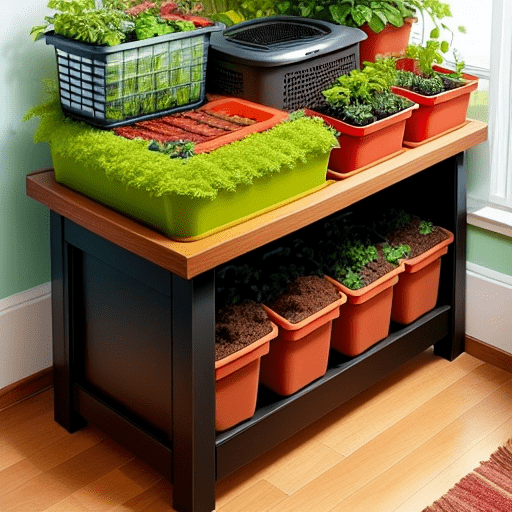Contents
- 1 Benefits of Composting
- 2 Supplies Needed
- 3 Choosing a Location
- 4 Setting Up the System
- 5 Adding Organic Materials
- 6 Frequently Asked Questions
- 6.1 How often do I need to turn the compost pile?
- 6.2 Is there a way to reduce the smell of the compost pile?
- 6.3 How can I tell when the compost is ready to use?
- 6.4 Are there any regulations or restrictions in my area regarding composting?
- 6.5 Can I use a composting system if I live in a small space or an apartment?
- 7 Conclusion
Composting is an amazing way to reduce your environmental footprint and help create a sustainable lifestyle. It’s easy to do even when living in an apartment, and the rewards are great!
With just a few simple steps and supplies you can have a composting system up and running in no time. In this article, we’ll cover the basics of creating a composting system in your apartment so you can start experiencing the benefits of composting for yourself.
Benefits of Composting
Composting is an easy way to make a positive impact on the environment and your wallet! It helps reduce waste by diverting organic material from landfills, keeps hazardous chemicals out of soil, and creates nutrient-rich compost for gardens or plants. Composting also reduces methane emissions that contribute to global warming.
Additionally, it eliminates the need for chemical fertilizers and pesticides, which can be expensive as well as bad for people’s health. Plus, you can save money on trash collection fees since you’re taking out less garbage. With all these benefits, it’s no wonder why composting is becoming increasingly popular!
Not only does composting help reduce environmental costs but it can also bring rewards in terms of sustainability and cost savings. By using food scraps to create nutrient-rich fertilizer for your garden or houseplants, you can cut down on purchasing costly store bought fertilizer and save money in the long run.
Moreover, creating a compost system in your apartment allows you to take control of what goes into your ecosystem while still reducing greenhouse gas emissions from landfills. With all these advantages in mind, let’s move onto the supplies needed to start composting in your apartment today!
Supplies Needed
You’ll need a few supplies to get your composting journey going, and it’s easier than you think!
To start off, pick up a compost bin. These come in all shapes and sizes, so choose one that fits the size of your apartment or balcony space.
You will also want to get some soil or mulch mix to help aerate the compost. You may even opt for an aerobic starter kit which includes enzymes and bacteria that speed up the process of breaking down food waste into usable compost.
Additionally, you may want to purchase a thermometer to monitor the temperature inside your bin since maintaining an ideal temperature is key for successful composting.
Finally, don’t forget about tools like trowels or shovels to turn your mixture as needed!
All these supplies together make it easy for you to create an effective compost system right at home.
Organizing and utilizing these supplies is essential for setting up a proper composting system in your apartment. With this knowledge at hand, you’re now ready to take on the next step: choosing a location where you can set up your bin safely and easily maintain its contents!
Choosing a Location
Choosing the right spot for your compost bin is crucial to ensure a successful composting experience – so make sure you pick the perfect place!
It should be easily accessible and close enough to your kitchen that it doesn’t become too much of a hassle. You’ll also want to consider what type of surface you’re placing your bin on (wooden floor, tiles, etc.), as well as how much light and air circulation the spot gets.
Additionally, if there are other people living with you in an apartment complex, think about where their bedrooms are located relative to your chosen spot. Compost bins can get smelly, so it’s important to make sure everyone will be comfortable with its location.
Once you’ve found the ideal area for your bin, it’s time to set up the system!
Setting Up the System
Setting up your compost bin is a breeze; just find the perfect spot and get ready to turn food scraps into nutrient-rich soil!
Start by selecting a container that’s designed for composting, preferably one with a handle for easy carrying. If you’re placing it on your balcony or patio, make sure it has an airtight lid to prevent pests from getting in. If you don’t have access to outdoor space, choose a small container that fits in the corner of your kitchen.
Make sure there’s sufficient airflow around the bin – if not, add some holes to ensure oxygen gets inside. Finally, line the bottom of your bin with newspaper strips or peat moss for moisture control and added insulation.
With these steps complete, you’re now ready to start adding organic materials!
Adding Organic Materials
Start adding organic materials to your bin to create a nutrient-rich soil that’ll transform your space! Begin by adding compostable items such as vegetable and fruit scraps, eggshells, coffee grounds, tea bags and any other natural biodegradable material.
Make sure that you’re not including animal products or dairy in the bin. A good ratio of green material (fruits and vegetables) to brown matter (dried leaves and twigs) is essential for creating the perfect composting environment.
You can also add manure from vegetarian animals like rabbits, horses, or cows as long as it has been aged for at least 6 months. To help break down all these materials even further, consider adding worms or fungi into the mixture so they can do their job aerating and enriching the soil with their waste.
Lastly, keep an eye on your compost’s moisture levels by regularly sprinkling water over it. This will ensure that everything continues breaking down properly inside the bin.
Frequently Asked Questions
How often do I need to turn the compost pile?
Turning your compost pile is a necessity when it comes to effectively creating compost. You should turn the pile at least once every two weeks.
This helps to aerate the materials in the compost and encourages faster decomposition by allowing oxygen to reach all parts of the pile, as well as fostering an environment in which beneficial bacteria can thrive.
If you have a larger or more active compost system, you may want to turn it more often, such as weekly or even daily if possible.
Turning your compost regularly will help ensure that you get nutritious and high-quality finished compost!
Is there a way to reduce the smell of the compost pile?
Yes, there are ways to reduce the smell of your compost pile. Start by making sure it’s well aerated – turning it regularly and adding more carbon-rich materials like dried leaves or cardboard will help with this.
You can also cover the top of your pile with a tarp or lid to keep out any moisture that could cause an odor. Finally, adding fresh, green materials like grass clippings and kitchen scraps in small amounts will help balance out the smell without creating too much heat or causing rot.
How can I tell when the compost is ready to use?
When compost is ready to use, you’ll know it. The material will be dark and crumbly, with a pleasant earthy smell. You should be able to break it apart easily between your fingers, and the material should feel dry and not sticky when touched.
If any of the materials are still recognizable, like pieces of food or leaves, then the compost isn’t finished yet. Keep adding more organic materials as needed and make sure you turn your pile regularly to give air circulation for faster decomposition.
Are there any regulations or restrictions in my area regarding composting?
Creating a compost pile in your area might have some regulations or restrictions that you need to be aware of. Before starting your composting system, it’s important to check with your local government to see what the guidelines are for composting in your area.
These can range from requiring permits, having certain size and location restrictions, or even banning composting altogether in some areas. Being informed on the regulations and restrictions surrounding composting is key when creating a successful system.
Can I use a composting system if I live in a small space or an apartment?
Yes, you can use a composting system even if you live in a small space or an apartment. Composting systems come in a variety of sizes and shapes, so there’s sure to be one that meets the size needs of your living situation.
In addition, many apartment buildings allow for composting bins as part of their waste management process. You can also look into container-based composters that can fit on a balcony or patio for easier access and maintenance.
Regardless of the type of composter you choose, it’s important to research local regulations and restrictions before setting up your system.
Conclusion
Creating your own composting system in your apartment is an easy and rewarding task that will help you reduce your waste, save money on fertilizer, and help the environment.
It takes a minimal investment of time and supplies to set up, and once it’s running, you’ll be able to enjoy the benefits of having nutrient-rich soil for years to come.
You don’t need a garden or outdoor space to do this – all you need is some creativity!
With a little effort and dedication, you can create an effective composting system in your apartment that will benefit both yourself and the planet.







